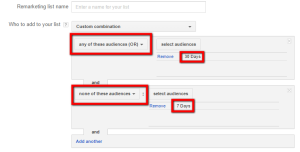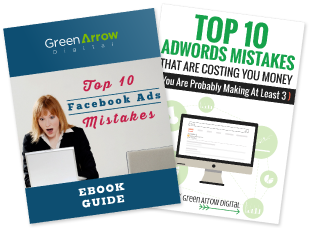I had been running ads for a while with reasonable success when one day, at a shopping centre, I had an epiphany. I was watching lots of people walking by, different people walking into different shops, people looking at different things to buy, some just killing time, some in a mad rush. We’ve all been in a shopping centre, you know what I am describing.
And it just dawned on me, what I was watching is exactly what happens online, just virtually. All the people walking by are just your general website visitors, and a subset of those people are looking to buy some of your products. Some have no intention to buy, some are browsing, and some just want to buy and leave.
This epiphany made me think each person as an individual and where they are at in their buying cycle. It also made me think of doing remarketing in a whole new way and how I could tailor my remarketing campaigns to match each person at the specific stage that they are at.
The old (and incorrect) way to do remarketing….
Remarketing has certainly come a long way when it came out and the old way is treating everyone the same. That is, show everyone an ad and also everyone the same ad!
Treating everyone the same by showing everyone the same ad is just wrong! Everyone is most definitely NOT the same and therefore they need different ads.
Sadly, many advertisers STILL do this and the end result is so much wasted ad spend AND annoying your past website visitors.
The right way to do remarketing?
The right way to do remarketing is to tailor your ads to match the individual. And you do this through segmentation. Segmenting people based on past behaviour.
This is best explained with an example.
Imagine you have 10,000 people on your remarketing list:
– 10% of those people left your website straight away – in technical terms, they ‘bounced’.
– 80% of those people are just browsing through all your products
– 10% of those people actually bought something.
The old way of doing remarketing would be to show all 10,000 people an ad and also show all of them the same ad. But, 1,000 of these people left straight away and will most likely never buy. And another 1,000 of those people bought something, so showing them an ad for something they just bought is useless.
The new way of doing remarketing, is showing an ad to only the 8,000 people who may buy something and haven’t bought yet.
So, how do you do this?
You first need to think of all the different types of people who come to your website.
First, let’s remove the buyers as we don’t want to show ads to people who have already purchased what we are showing an ad for.
How do you remove buyers from your remarketing list?
You need to find the Thank You page URL (the page that someone lands on once they have purchased) and create a dedicated list of everyone who lands on that specific page. Once you have identified these people, you can them REMOVE them from a campaign.
1. Go to your remarketing campaign.
2. Under the Display Network tab, click on +Targeting
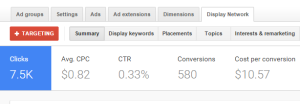
3. Under “Campaign exclusions”, click on “Add campaign exclusions”, and select “interests & remarketing”.

4. Click “Site category” drop-down, then select “Remarketing Lists”.
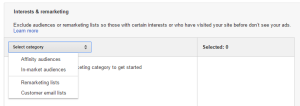
5. Select all the lists that you have created for those who have purchased.
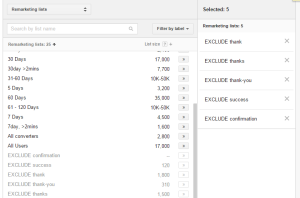
6. Click on Save
You can actually take this a step further, and show all the buyers an ad for a product that goes with something they just purchased. For example, special sweat socks to go with the running shoes they just purchased. But, I digress.
Next, let’s remove the people who bounced. After all, if they weren’t interested in our products then, it is unlikely they will be interested now. Note; depending on how much traffic you do get to your site, this may be a small or large amount of people.
To remove the people who bounced, you need to link your Analytics and AdWords accounts together.
Now, we have the remaining 80% of people who were browsing that we can show ads to.
Why stop there?
We can even take this another step further…. And divide up the 80% group into sub segments. Why? Because reality is, some people are just not ready to buy and that’s just fine.
So, continuing with our example, of the browsers (the 80% group),
– 30% of them had been to our site in the past 24 hours,
– 50% spent had been to our site in the past week,
– and 20% hadn’t been to our site in the last 30 days.
So, by creating a sub segment, we can adjust our bidding based on the time of their last visit.
Why would you want to do this? This is a really important point as by adjusting your bidding, it will ensure you are spending more money on people who are worth more to your business. Equally important, you are spending less money on people who are not worth as much to your business.
The key here is in identifying these people and the characteristics they possess. Because the point is, everyone is at a different point in their buying cycle. So, you need to be able to show different ads to different people which matches where they are in their buying cycle.
How do you do this? Remarketing based on time since last visit
Once again, you do this through ‘lists’ and create a bunch of different lists of different duration.
So, to be clear, you create the following lists (these are just some examples, so do what is appropriate in your business):
– 1 day list (everyone who has been to your site in the last 24 hours)
– 7 day list (everyone who has been to your site in the last 7 days)
– 14 day list
– 30 day list
– 90 day list
– 365 day list
– 540 day list (note, this is the maximum duration available)
Then, as we explained in the previous example, you can combine 2 lists together, to create a brand new list of unique characteristics.
For example, if I combine the 7 day and 30 day lists together, I can effectively say, I want everyone who has been to my site in the last 30 days, but NOT in the last 7 days.
We can explain exactly how to do this in another post, but for now, you can appreciate the power of doing remarketing this way.
By doing it this way, you are paying more for someone who has been to your site recently, and less for someone who hasn’t visited in a while. You’ll probably end up spending the same total amount on your remarketing campaign, but essentially, it is a reallocation of budget within the campaign.
So, hopefully you can now get a sense of the true power of remarketing, with the true power being in how you can tailor it to your own business.
Good luck!
